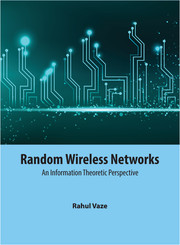Book contents
- Frontmatter
- Dedication
- Contents
- List of Figures
- Preface
- Acknowledgments
- Notation
- 1 Introduction
- 2 Transmission Capacity of ad hoc Networks
- 3 Multiple Antennas
- 4 Two-Way Networks
- 5 Performance Analysis of Cellular Networks
- 6 Delay Normalized Transmission Capacity
- 7 Percolation Theory
- 8 Percolation and Connectivity in Wireless Networks
- 9 Throughput Capacity
- Index
- References
6 - Delay Normalized Transmission Capacity
Published online by Cambridge University Press: 05 May 2015
- Frontmatter
- Dedication
- Contents
- List of Figures
- Preface
- Acknowledgments
- Notation
- 1 Introduction
- 2 Transmission Capacity of ad hoc Networks
- 3 Multiple Antennas
- 4 Two-Way Networks
- 5 Performance Analysis of Cellular Networks
- 6 Delay Normalized Transmission Capacity
- 7 Percolation Theory
- 8 Percolation and Connectivity in Wireless Networks
- 9 Throughput Capacity
- Index
- References
Summary
Introduction
In the first part of this book, we considered the single-hop model of a wireless network, where each source–destination pair is at a fixed distance from each other and performs direct communication between themselves. For the single-hop model, we introduced the concept of transmission capacity to characterize the spatial capacity and derived it for many different strategies such as scheduling, multiple antenna transmission, and two-way communication.
Even though the single-hop model is elegant, it is not realistic in a large wireless network, where the primary mode of operation is hop-by-hop communication from each source to its destination using multiple relay nodes. Three important distinctions between single-hop and multi-hop communications are i) routing protocol, finding optimal routes for each source and destination, ii) retransmissions, any relay can forward packet only after it receives it successfully, which potentially requires retransmissions, and iii) shared relay nodes that are used by many source–destination pairs.
In this second part of the book, we exclusively consider the multi-hop communication model for wireless networks. In this chapter, we begin by extending the transmission capacity framework to allow retransmissions using ARQ over multiple hops, and define a new notion called the delay normalized transmission capacity that normalizes the end-to-end throughput with the expected number of retransmissions required for successful delivery of any packet at the destination. We analyze the delay normalized transmission capacity for a simple multi-hop model, where each source–destination pair is at a fixed distance from each other and there are dedicated relays between each source and its destination. Even though this model is simple, it still allows us to capture the interplay of three important quantities: throughput, delay, and reliability, in a multi-hop wireless network.
Even with this simple model, the analysis of the delay normalized transmission capacity is quite involved, and the exact derived expressions are not in the simplest closed form.
- Type
- Chapter
- Information
- Random Wireless NetworksAn Information Theoretic Perspective, pp. 116 - 145Publisher: Cambridge University PressPrint publication year: 2015



